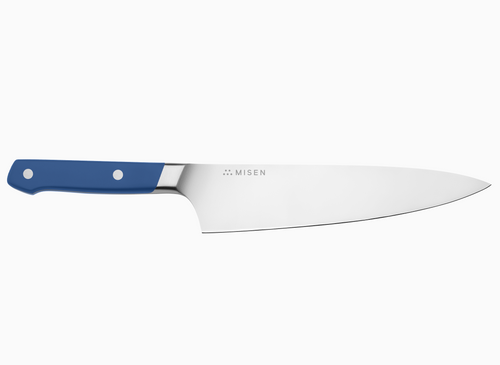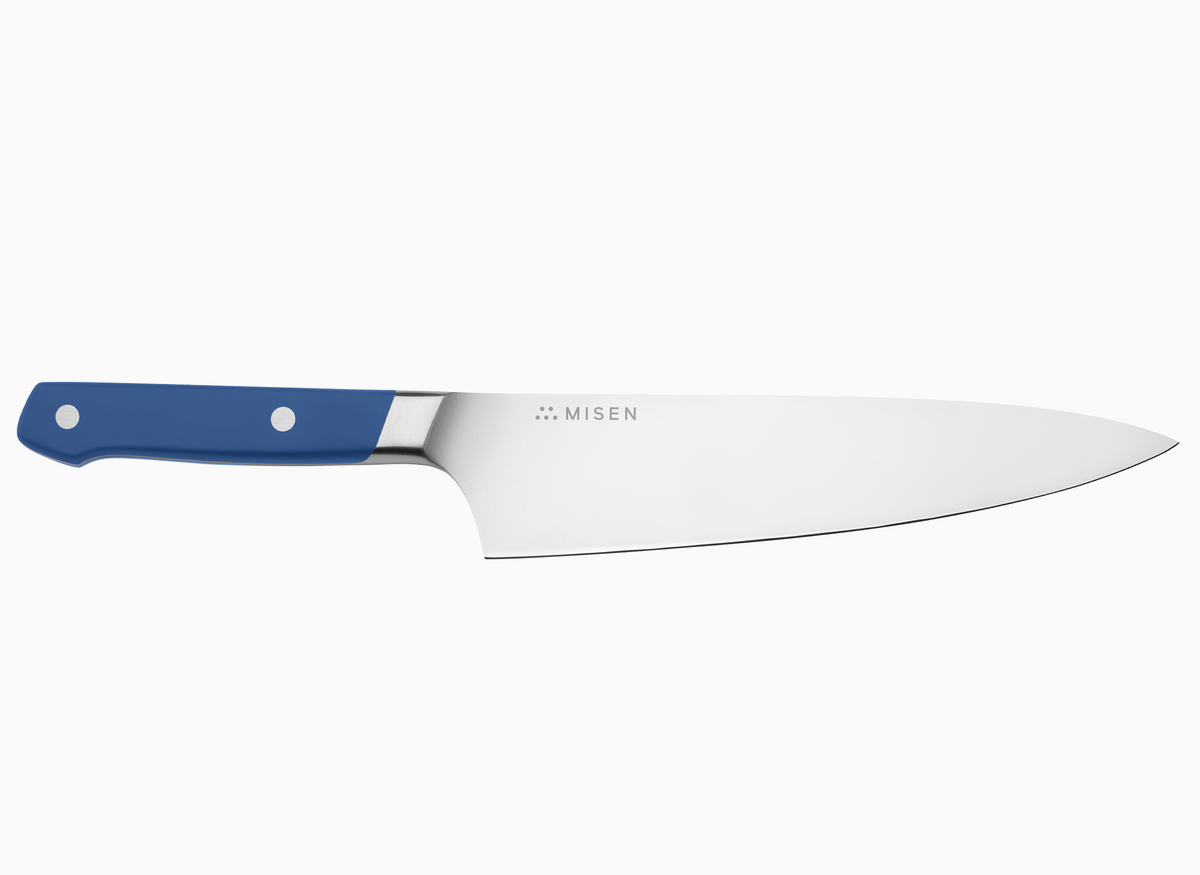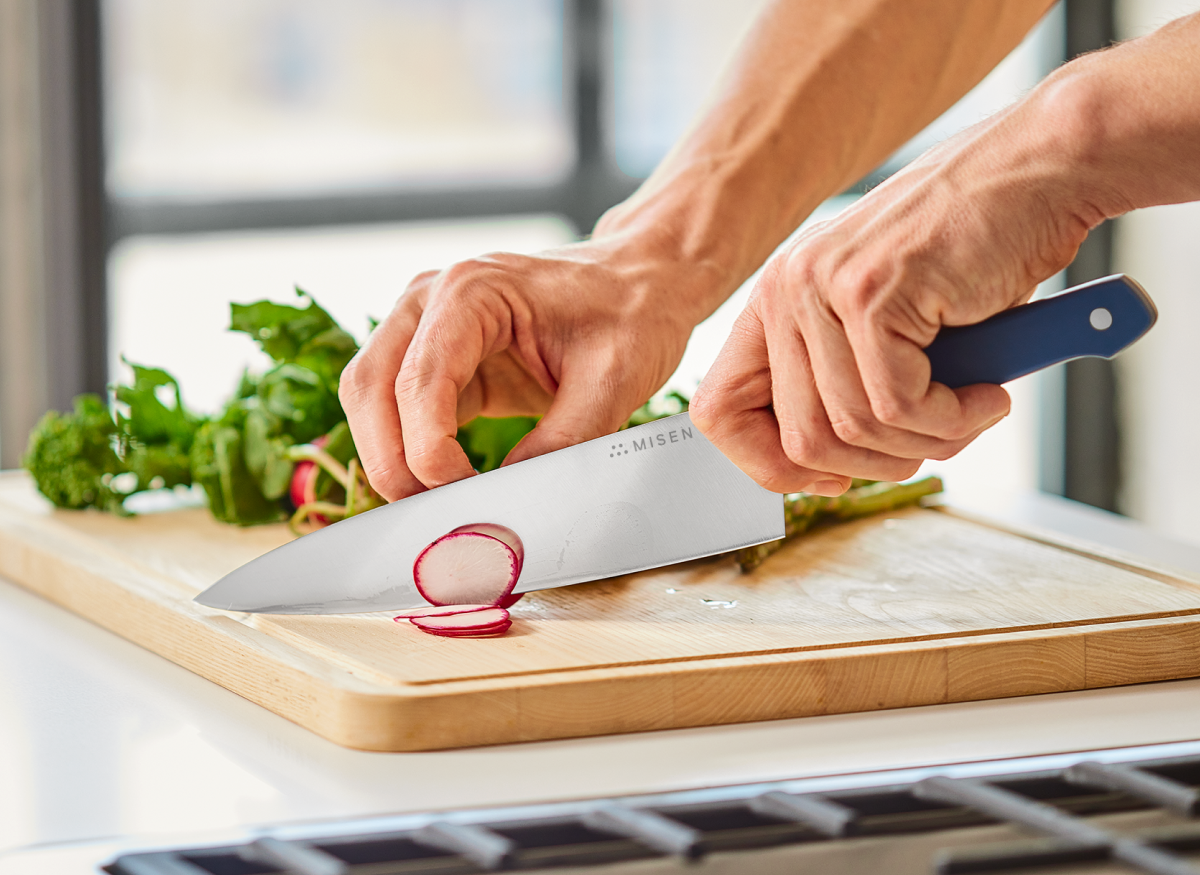Are German Knives Better Than Japanese Knives?
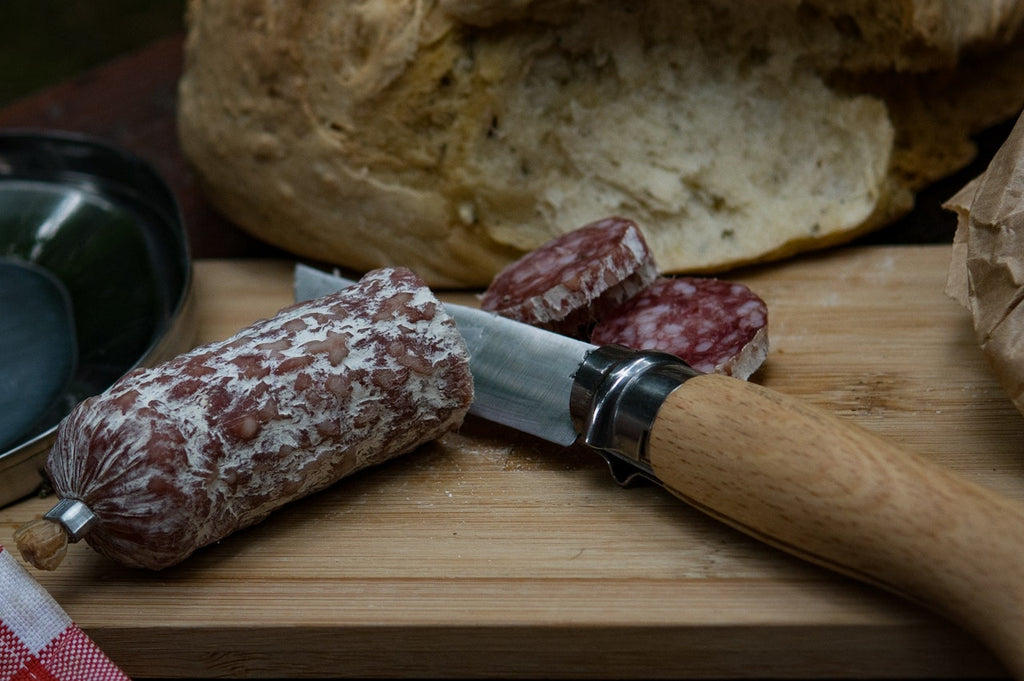 German knives are sturdier for cutting through dense food.
German knives are sturdier for cutting through dense food.
- German knives are more robust.
- Japanese blades offer precision.
- Both countries have begun to adopt each other’s characteristics as consumers demand the best of both.
Germany and Japan have been known for their knife making skills for centuries. Both boast some of the most popular knife brands in the world. To make a confident decision when buying a high-quality kitchen knife, you need to know the characteristics that set them apart. The differences mostly lie in style with the biggest difference coming from the type of steel used in the blade.
Over time, knife makers have adopted elements from both the German and Japanese knife-making styles. It’s narrowed the gap that distinguishes each style — but you’ll still have to choose which of these distinct features you want in your knife. Here are things you need to know to make that decision.
The Knife Steel
The type of steel used for the knife blade is the essential area where German and Asian knife makers frequently part ways. Japanese cutlery manufacturers have traditionally preferred harder steel.
Steel hardness is measured with the Rockwell scale. The higher on the scale, the harder the steel. Harder steel also becomes more brittle. Blades made of hard steel are susceptible to chipping.
German-Style Steel
German knives are usually made with stainless steel, which has a Rockwell scale rating of 56-58. Stainless steel contains chromium. This is what lowers the Rockwell scale rating. The benefit is a knife blade that resists corrosion and rust.
Cooks generally agree that German-style, stainless steel knife blades are hardier than Japanese-style blades. There’s less concern about chipping or breaking the blade of a German-style knife. Its durability means you can use it for more cutting and chopping tasks.
The softer characteristic of the steel still provides a sharp edge, but stainless steel will require you to hone and sharpen it more often. The softer steel also makes the blade easier to sharpen the blade — even though a stainless steel blade means that a German knife will lose its sharp edge quicker than its Japanese counterpart, which is made of high-carbon steel.
Japanese-Style Steel
Knives made by Japanese manufacturers traditionally use high-carbon steel. It’s a superior material for knife blades because it holds its super-sharp edge longer than stainless steel, due to a rating of 60-61 on the Rockwell scale. High-carbon steel is significantly harder but also more brittle.
High carbon steel is super-strong stuff, and yet it’s no match for the humble tomato. The lack of an alloy like chromium, which helps stainless steel resist corrosion and rust, leaves high-carbon steel susceptible to acidic foods like citrus and the aforementioned tomato. Unless it’s immediately cleaned and thoroughly dried after contact with acid, a high-carbon steel knife blade will darken or even turn black.
There is a benefit to this harder, lighter steel. It makes for an edge that will stay sharper longer. If you’re careful not to damage the blade, you’ll spend less time maintaining a Japanese-style knife.
The Hybrid Solution
Because most modern knife makers borrow a bit from the German knife-making style and a bit from the Japanese knife-making style, it’s no surprise that knife makers seek out a metal that offers the hardness of high-carbon steel and sturdiness of stainless steel. High-carbon stainless steel gives you the best of both worlds. It has a higher Rockwell scale rating, so you’ll get a knife that will maintain its sharp edge longer. But, you’ll also be able to worry less about chipping or snapping the blade.
Misen knives are made with Aichi Steel, which offers a great balance of sharp edge retention and durability with 60 percent more carbon content than other “premium” knives.
Blade Shape
If you place a Japanese-style kitchen knife next to a German-style one, you’ll see that the Japanese knife makers prefer a blade shape that’s less rounded and that has a less drastic taper at the tip. This straighter silhouette helps you make clean and precise slices.
German-style knife blades have a characteristic gentle curve from the bolster all the way to the tip. It helps to facilitate the rocking action that’s most efficient for mincing and chopping. This motion is helped even more by the heel of the knife’s bolster, which is where you would bring it down to start.
The Knife Blade Bevel
A knife blade has to be sharp to efficiently cut or chop. The blade’s bevel is responsible for this degree of sharpness. The bevel is the area of the blade that is ground to form the sharp edge.
If you look closely (and carefully) at a knife blade, you’ll see a slight angle or slope on one or both sides, which runs down to the edge. There’s a precise measurement for this angle, and it’s one of the things that differentiates German-style knives from Japanese-style knives.
German-Style Bevel
German blades are typically sharpened to create a bevel of about 20 to 25 degrees — meaning a 40–50-degree angle along the knife blade. The wider bevel is beneficial because the overall weight and mass of the knife blade offers more strength to push the blade through thicker, tougher objects.
You’ll feel more confident using a German-style knife to cut through the rind of a watermelon or slice through the tendons connecting a rack of lamb.
Japanese-Style Bevel
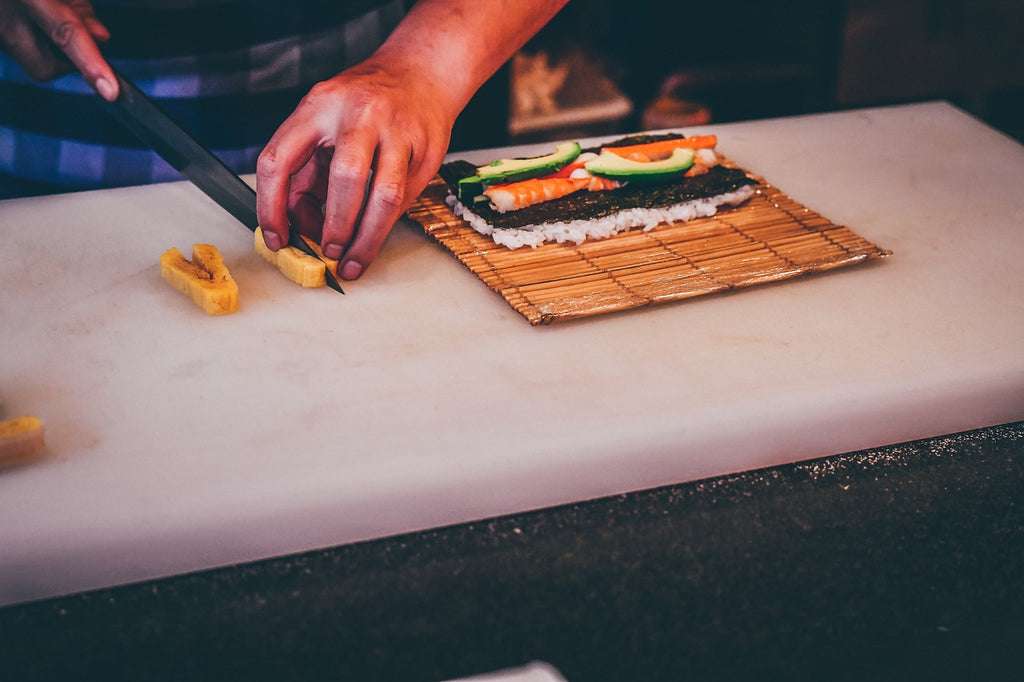 Japanese knifes are thinner and sharper for cutting through delicate items, like sushi, with precision.
Japanese knifes are thinner and sharper for cutting through delicate items, like sushi, with precision.
Many quality Japanese-style knives have a more acute angle on the bevel of the blade. This makes the knife sharper, but it also makes the edge that’s doing the cutting more delicate. Generally, Japanese-style knives have a beveled angle on the blade edge of about 15 degrees. This means the overall angle of the blade is 30 degrees.
The acute angle allows a knife to efficiently slice through fruits, vegetables, and even raw fish, without excess damage to the food’s cell walls. This preserves both taste and texture.
Japanese knife makers like Shun, Global, and Masahiro are known for their razor-sharp, light-weight blades. If you’re familiar with the exquisite detail that goes into making Japanese cuisine, it’s easy to see why elements that provide precision and control are important. Food presentation has been perfected into an artform in this country, called katsuramuki. And let’s not forget about the dexterity and control needed to prepare raw fish for sushi and sashimi.
Some people prefer the additional sharpness of a Japanese-style blade with its more acute cutting angle. Others feel less secure with the lighter and less thick blade. They want to feel some weight behind the knife.
The Weight of the Knife
You’ll notice a difference right away when you pick up a German-style knife and feel its heft. German knife makers like Wüsthof, Victorinox, and Zwilling J.A. Henckels are known for manufacturing knives that are more robust. The blades utilize more steel that Japanese knives, which makes the German knives heavier. The additional material in German or Western-style knives is noticeable in two main areas: the tang and the bolster.
German-Style Knife Tang
German-style knives are often characterized by their use of a full tang. The tang of a knife is the portion of the blade that extends into the handle. German knife makers tend to use a full tang. It means that the metal continues right to the end or butt of the handle.
A full tang provides stability and durability because of the integrity it adds to the knife. It also helps balance the knife. Consider how substantial the handle would have to be to offer counterweight to an 8-10 inch steel blade. A full tang ensures that the handle slightly outweighs the blade. Otherwise, the knife might have a tendency to pull downward toward the blade when you hold it in your hand.
Japanese-Style Knife Tang
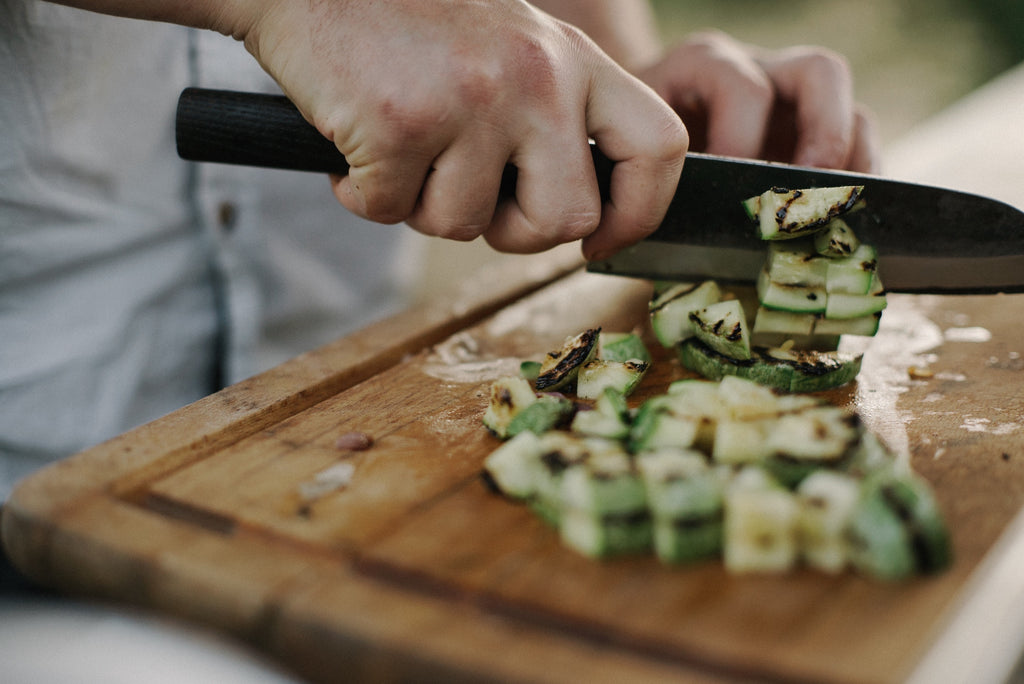 The santoku is originally a Japanese knife that's now offered by both German and Japanese knife makers.
The santoku is originally a Japanese knife that's now offered by both German and Japanese knife makers.
While you can find full-tang knives made by Japanese knife makers, most Japanese-style knives have partial tangs. This means that the metal of the blade doesn’t run the full length of the knife. If often tapers inside the handle.
Cutting down on the amount of steel used decreases the knife’s overall weight. If you pick up a Japanese-style knife with a partial tang, you’ll feel that the weight is distributed toward the blade or top of the handle. Some people prefer this characteristic because they say it enables them to make more controlled movements.
German-Style Bolster
German-style knives also almost always have a bolster. It’s the thick junction between the handle and the knife blade. If you’re curious about how thick the original piece of steel was that made a knife, the bolster will tell you.
The bolster is where your finger and thumb usually come to rest to guide your knife actions. The center of balance is often just before the bolster. The bolster may not extend all the way to the bottom of the knife blade.
Besides contributing weight and helping to balance the knife, fans of German-style knives appreciate the bolster because it adds further protection by keeping your fingers away from the blade.
Japanese-Style Bolster
Most full tang knives feature a bolster. Many Japanese-style knives — which don’t have full tangs — also lack a bolster. The blade tends to abruptly end where it disappears as a partial tang into the handle. This style allows your fingers to be in close proximity to the sharp blade, which may provide more control.
What Will You Do With Your Knife?
Now that you understand what different knife styles can help you do, it’s time to decide which style will work best in your kitchen. Knives are for cutting things up. Generally, though, a cook has an overall task. The knife style you choose should help you be more efficient with that task.
“There’s no one right knife,” Taylor Erkinnen, founder and chief creative officer of Brooklyn Kitchen told blogger Geraldine Campbell in an article for kitchn. “I have far too many knives that don’t all fit on the knife bar.” According to Campbell, the most important consideration is your own cutting style.
You might not use the rocking chop style of a German knife. In that case, the non-curved shape of a Japanese-style knife might be more to your liking. You may spend a lot of time chopping dense food, in which case, the German knife might make your kitchen prep easier.
Less Is More
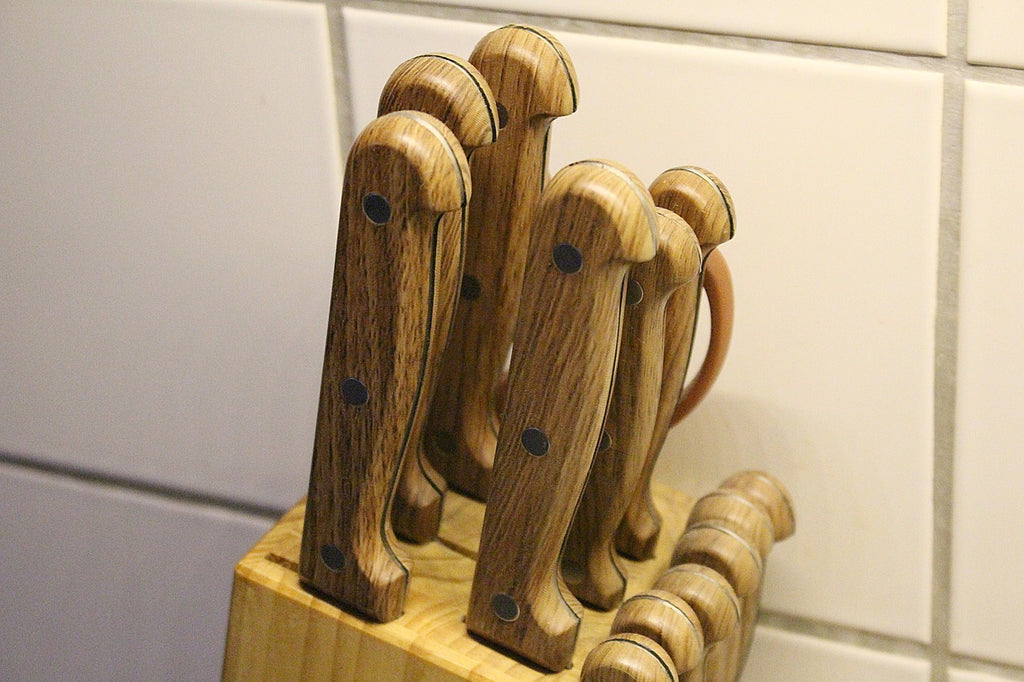 Instead of a set, buy each knife separately so you can choose some German and some Japanese knives.
Instead of a set, buy each knife separately so you can choose some German and some Japanese knives.
Knives are the basic building blocks for cooking preparation, but that doesn’t mean you need every knife that comes in a knife set. When you buy that big knife block set, you might end up with a set of steak knives, a bread knife, a carving knife, a boning knife, and even kitchen shears — but do you really need them?
The amount of money you’ll pay for a block of 12-18 low-quality knives can easily cover the investment in a quality chef’s knife and paring knife.
It would even cover the cost of adding a santoku knife. It’s a hybrid of the German- and Japanese-style blade shape, featuring a rounded down tip and a blade with less curve that helps you focus on chopping. You’ll appreciate the German-style full tang combined with a Japanese-style semi bolster of this amazing cook's knife.
Kitchen Workhorse
Most people are looking for an all-purpose knife that’s durable enough to use with confidence. For something that offers the best of both Japanese-style and German-style, consider buying a Misen chef’s knife. It combines the most wanted features from both blade styles, offering versatility that may be difficult to find in other quality knives.

